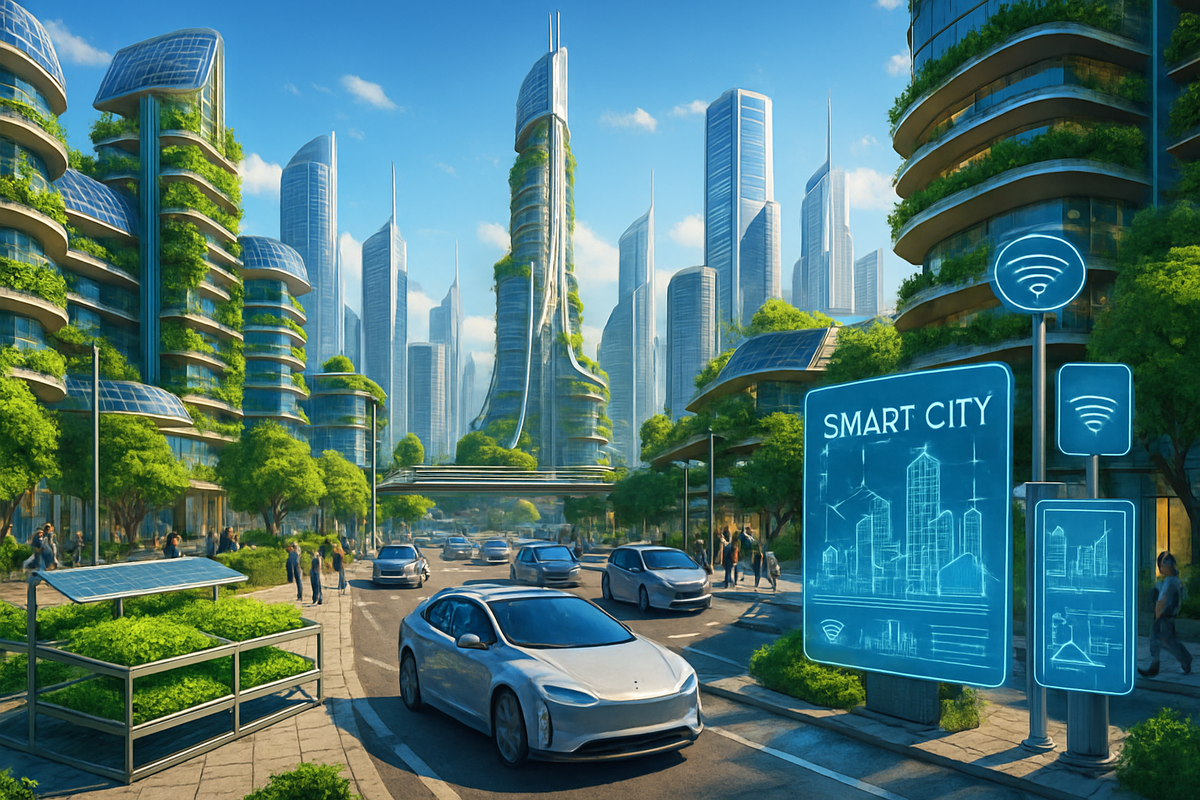The 2025 Smart City Playbook: How AI, Digital Twins, and Climate Tech Are Revolutionizing Urban Life
Discover how smart cities of 2025 are reshaping urban life with AI governance, climate tech, and vertical farming. This playbook offers actionable insights for revolutionizing transit, energy, and food systems in your city. Join the urban revolution today!

THE 2025 SMART CITY PLAYBOOK
Welcome to the Urban Revolution
Picture this: It’s 2025. Your morning commute is orchestrated by AI, your building breathes with the weather, and your salad was harvested—in your apartment. The world’s cities are not just growing—they’re getting smarter, faster, and (dare we say) a whole lot cooler.
But what’s behind the hype? If you’re a city planner, tech entrepreneur, or an urbanite who wants more than pothole-free streets, this playbook is your ticket to decoding the real smart city revolution. We’ll cover:
- AI-powered governance and real-time decision-making
- Digital twins (not the Matrix, but close!) for city-scale simulation
- Climate tech and disaster resilience
- Urban farming and food security for the high-rise age
- Zero-emission mobility and hyper-efficient transit
- Practical, actionable steps for pros and everyday citizens
“Smart cities aren’t just about connected gadgets—they’re about connected people, purpose, and planet.”
The AI Brain: How Artificial Intelligence Is Governing Cities
Move over, SimCity. Real urban planning in 2025 is powered by AI algorithms that juggle traffic, optimize energy grids, and even predict emergencies before they happen. In Pittsburgh, AI-driven traffic lights have reduced travel times by 25% and emissions by 20%. Meanwhile, Dallas deploys AI video analytics to cut crime rates by up to 40%—and response times by a third.
From predictive policing to dynamic public transit scheduling, AI is the invisible hand making cities safer, greener, and more livable. For city leaders, the message is clear: If your data isn’t working for you, you’re working for your data.
Action Steps:
- Audit your city’s data streams—are they siloed or actionable?
- Explore open-source AI tools for civic engagement (think chatbots for city services!)
- Engage residents through transparent dashboards—public trust is the ultimate algorithm
Digital Twins: Simulating Cities, Preventing Nightmares
Imagine a virtual copy of your entire city—buildings, roads, utilities, even people—running in real time. Digital twins are no longer sci-fi. Singapore, Helsinki, and Dublin already simulate the ebb and flow of traffic, weather events, and construction delays to test solutions before they hit the real world.
Why does this matter? Digital twins let planners stress-test disaster scenarios, optimize building energy use, and even model the impact of new parks on neighborhood health. It’s like a rehearsal dinner for urban innovation—without the awkward speeches.
Quick Start for Planners and Techies:
- Start small: Create a digital twin for a single neighborhood or transit corridor.
- Integrate IoT sensor data for real-time feedback.
- Use simulations to engage citizens in design decisions—let them "see" the future!
Climate Resilience: Urban Survival in the Age of Extremes
2025 is the year climate tech gets real. Extreme weather, heatwaves, and flooding are forcing cities to adapt, fast. Enter biosolar rooftops that cut cooling needs by 25% and microgrids that keep the lights on when disaster strikes. In California, Tesla-run virtual power plants already supply 100MW of clean backup power during blackouts.
Meanwhile, platforms like Google’s Flood Hub now send AI-powered flood alerts to 700 million people across 100 countries. And in South Korea, entire neighborhoods are built with underground pneumatic waste systems—no garbage trucks, no rats, no problem.
Resilience Playbook:
- Assess your city’s climate vulnerabilities—heat, flooding, energy, food.
- Pilot microgrid or community battery projects for energy security.
- Tap into real-time disaster alert platforms and integrate with local emergency services.
Urban Farming: Food Security Goes Vertical
By 2029, urban farming is projected to be a $233 billion market. Why? Because cities can’t afford to truck in tomatoes from 1,000 miles away. Enter vertical farms—hydroponic towers, aeroponic modules, and even in-restaurant growing units. Singapore’s Sky Greens produces fresh veggies daily with a fraction of the land and water.
AI and IoT sensors fine-tune light, humidity, and nutrients, making it possible to grow food year-round in basements, rooftops, or even old shipping containers. Some systems use robotic bees for pollination (yes, really).
How to Get Growing:
- Try a countertop hydroponic kit for your home or office.
- Restaurants: Pilot on-site vertical farming—fresh greens, zero food miles.
- Cities: Offer incentives for rooftop or community farms. The future is edible!
Zero-Emission Mobility: The End of the Traffic Jam?
Traffic may be as old as cities themselves, but 2025 is rewriting the rules. AI-powered traffic systems like Pittsburgh’s SURTRAC cut travel time and emissions. Amsterdam’s real-time parking sensors reduce "search traffic" and CO2. Robotaxis, smart parking, and Mobility-as-a-Service apps are turning car ownership into an option—not a necessity.
On the horizon: eVTOL air taxis (think flying Ubers), and smart walkways that move you along at 10mph. (Warning: coffee not included.)
Your Urban Mobility Checklist:
- Switch to electric bikes, scooters, or shared EVs for short trips.
- Use multimodal apps to plan seamless journeys across bus, train, and rideshare.
- Support your city’s investments in charging infrastructure and smart corridors.
Smart Buildings: Living, Breathing, and Learning Spaces
Buildings now consume 30% of global energy—but smart tech is slashing this by up to 40%. IoT sensors, automated HVAC, and real-time air quality monitors are the new normal. Singapore aims for 80% green-certified buildings by 2030, and Helsinki’s Wood City is pioneering high-rise timber towers with integrated smart systems.
For tenants and managers, the benefits are tangible: lower bills, healthier air, and a dashboard for everything from leak detection to guest access.
Smart Building To-Do’s:
- Retrofit with smart thermostats and leak sensors.
- Monitor indoor air quality and automate ventilation.
- Consider green building materials for your next renovation.
E-Governance & Digital Citizenship: Democracy at the Speed of Light
Smart cities aren’t just tech showcases—they’re reinventing how we interact with government. In India, digital platforms have completed 90% of smart city projects across 100 cities. Over 50 countries now offer fully online tax, licensing, and business services. Blockchain is being used for property titles, and AI chatbots answer your city queries in real time.
The result? Faster, more transparent, and (dare we say) more pleasant government experiences.
From Playbook to Practice: Your Next Steps
Whether you’re a mayor, a startup founder, or just someone who wants a smarter, greener city, here’s how you can take action:
- Get involved: Join local smart city initiatives or urban innovation labs.
- Upgrade your home: Experiment with smart devices, energy monitors, or a tiny vertical farm.
- Advocate: Push for climate resilience, open data, and digital services in your community.
- Stay curious: Cities are changing fast—keep learning, and help shape the conversation.
Want to go deeper? Only Funaix Insiders can read and write blog comments, get exclusive updates, and shape our coverage. Subscribe free today—and help build the cities of tomorrow.
Written on August 16, 2025 · For more smart city insights, subscribe free at Funaix. Only subscribers can join the conversation.




